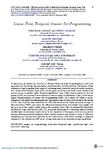Mostrar o rexistro simple do ítem
Linear-Time Temporal Answer Set Programming
| dc.contributor.author | Aguado, Felicidad | |
| dc.contributor.author | Cabalar, Pedro | |
| dc.contributor.author | Diéguez Lodeiro, Martín | |
| dc.contributor.author | Pérez, Gilberto | |
| dc.contributor.author | Schaub, Torsten | |
| dc.contributor.author | Schuhmann, Anna | |
| dc.contributor.author | Vidal, Concepción | |
| dc.date.accessioned | 2023-03-31T19:09:12Z | |
| dc.date.available | 2023-03-31T19:09:12Z | |
| dc.date.issued | 2023 | |
| dc.identifier.citation | F. Aguado et al., «Linear-Time Temporal Answer Set Programming», Theory and Practice of Logic Programming, vol. 23, n.º 1, pp. 2-56, ene. 2023, doi: 10.1017/S1471068421000557. | es_ES |
| dc.identifier.issn | 1471-0684 | |
| dc.identifier.uri | http://hdl.handle.net/2183/32822 | |
| dc.description.abstract | [Abstract]: In this survey, we present an overview on (Modal) Temporal Logic Programming in view of its application to Knowledge Representation and Declarative Problem Solving. The syntax of this extension of logic programs is the result of combining usual rules with temporal modal operators, as in Linear-time Temporal Logic (LTL). In the paper, we focus on the main recent results of the non-monotonic formalism called Temporal Equilibrium Logic (TEL) that is defined for the full syntax of LTL but involves a model selection criterion based on Equilibrium Logic, a well known logical characterization of Answer Set Programming (ASP). As a result, we obtain a proper extension of the stable models semantics for the general case of temporal formulas in the syntax of LTL. We recall the basic definitions for TEL and its monotonic basis, the temporal logic of Here-and-There (THT), and study the differences between finite and infinite trace length. We also provide further useful results, such as the translation into other formalisms like Quantified Equilibrium Logic and Second-order LTL, and some techniques for computing temporal stable models based on automata constructions. In the remainder of the paper, we focus on practical aspects, defining a syntactic fragment called (modal) temporal logic programs closer to ASP, and explaining how this has been exploited in the construction of the solver telingo, a temporal extension of the well-known ASP solver clingo that uses its incremental solving capabilities. | es_ES |
| dc.description.sponsorship | Xunta de Galicia; ED431B 2019/03 | es_ES |
| dc.description.sponsorship | We are thankful to the anonymous reviewers for their thorough work and their useful suggestions that have helped to improve the paper. A special thanks goes to Mirosaw Truszczy´nski for his support in improving the quality of our paper. We are especially grateful to David Pearce, whose help and collaboration on Equilibrium Logic was the seed for a great part of the current paper. This work was partially supported by MICINN, Spain, grant PID2020-116201GB-I00, Xunta de Galicia, Spain (GPC ED431B 2019/03), R´egion Pays de la Loire, France, (projects EL4HC and etoiles montantes CTASP), European Union COST action CA-17124, and DFG grants SCHA 550/11 and 15, Germany. | es_ES |
| dc.language.iso | eng | es_ES |
| dc.publisher | Cambridge University Press | es_ES |
| dc.relation | info:eu-repo/grantAgreement/AEI/Plan Estatal de Investigación Científica y Técnica y de Innovación 2017-2020/PID2020-116201GB-I00/ES/RAZONAMIENTO AUTOMATICO Y APRENDIZAJE CON INDUCCION DE CONOCIMIENTO | es_ES |
| dc.relation.uri | https://doi.org/10.1017/S1471068421000557 | es_ES |
| dc.rights | Atribución 3.0 España | es_ES |
| dc.rights.uri | http://creativecommons.org/licenses/by/3.0/es/ | * |
| dc.subject | answer set programming | es_ES |
| dc.subject | linear-time temporal logic | es_ES |
| dc.subject | equilibrium logic | es_ES |
| dc.subject | non-monotic reasoning | es_ES |
| dc.title | Linear-Time Temporal Answer Set Programming | es_ES |
| dc.type | info:eu-repo/semantics/article | es_ES |
| dc.rights.access | info:eu-repo/semantics/openAccess | es_ES |
| UDC.journalTitle | Theory and practice of logic programming | es_ES |
| UDC.volume | 23 | es_ES |
| UDC.issue | 1 | es_ES |
| UDC.startPage | 2 | es_ES |
| UDC.endPage | 50 | es_ES |
Ficheiros no ítem
Este ítem aparece na(s) seguinte(s) colección(s)
-
GI-IRlab-Artigos [24]






